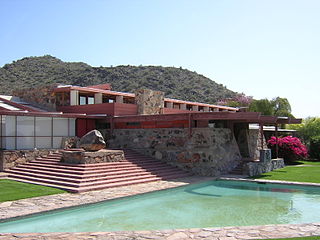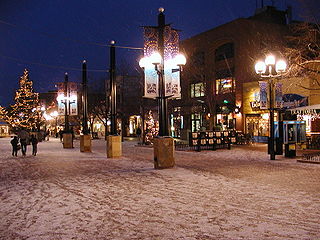Related Research Articles

Frank Lloyd Wright was an American architect, designer, writer, and educator. He designed more than 1,000 structures over a creative period of 70 years. Wright played a key role in the architectural movements of the twentieth century, influencing architects worldwide through his works and hundreds of apprentices in his Taliesin Fellowship. Wright believed in designing in harmony with humanity and the environment, a philosophy he called organic architecture. This philosophy was exemplified in Fallingwater (1935), which has been called "the best all-time work of American architecture".

Bonsai is the Japanese art of growing and training miniature trees in containers, developed from the traditional Chinese art form of penjing. Penjing and bonsai differ in that, the former, attempts to display “wilder,” more naturalistic scenes, often representing landscapes, including elements such as water, rocks or figurines; on the other hand, bonsai typically focuses on a single tree or a group of trees of the same species, with a higher level of aesthetic refinement. Similar versions of the art exist in other cultures, including the miniature living landscapes of Vietnamese Hòn non bộ. It was during the Tang dynasty, when penjing was at its height, that the art was first introduced in Japan.

William Wesley Peters was an American architect and engineer, apprentice to and protégé of Frank Lloyd Wright.
The Huntington Library, Art Museum and Botanical Gardens, known as The Huntington, is a collections-based educational and research institution established by Henry E. Huntington (1850–1927) and Arabella Huntington (c.1851–1924) in San Marino, California, United States. In addition to the library, the institution houses an extensive art collection with a focus on eighteenth- and nineteenth-century European art and seventeenth- to mid-twentieth century American art. The property also has approximately 120 acres (49 ha) of specialized botanical landscaped gardens, including the "Japanese Garden", the "Desert Garden", and the "Chinese Garden".

Garrett Eckbo was an American landscape architect notable for his seminal 1950 book Landscape for Living.

Thomas Dolliver Church was a 20th century landscape architect based in California. He is a nationally recognized as one of the pioneer landscape designers of Modernism in garden landscape design known as the 'California Style'. His design studio was in San Francisco from 1933 to 1977.

Taliesin, sometimes known as Taliesin East, Taliesin Spring Green, or Taliesin North after 1937, is a property located 2.5 miles (4.0 km) south of the village of Spring Green, Wisconsin, United States. It was the estate of American architect Frank Lloyd Wright and an extended exemplar of the Prairie School of architecture. The 600-acre (240 ha) property was developed on land that originally belonged to Wright's maternal family.

Taliesin West was architect Frank Lloyd Wright's winter home and studio in the desert from 1937 until his death in 1959 at the age of 91. Today it is the headquarters of the Frank Lloyd Wright Foundation.

Daniel Urban Kiley was an American landscape architect, who worked in the style of modern architecture. Kiley designed over one-thousand landscape projects including Gateway Arch National Park in St. Louis.

Mary Bouton "Mamah" Borthwick was an American translator who had a romantic relationship with architect Frank Lloyd Wright, which ended when she was murdered. She and Wright were instrumental in bringing the ideas and writings of Swedish feminist Ellen Key to American audiences. Wright built his famous settlement called Taliesin in Wisconsin for her, in part, to shield her from aggressive reporters and the negative public sentiment surrounding their non-married status. Both had left their spouses and children in order to live together and were the subject of relentless public censure.

Hideo Sasaki was a Japanese American landscape architect.
Robert Murase was an American landscape architect. He worked throughout the Pacific Northwest in the field of landscape design.

Antonin Raymond, born as Antonín Reimann was a Czech American architect. Raymond was born and studied in Bohemia, working later in the United States and Japan. Raymond was also the Consul of Czechoslovakia to Japan from 1926 to 1939, in which year the Czech diplomacy was closed down after the occupation of the European country by Nazi Germany.

Robert N. Royston was one of America's most distinguished landscape architects, based in the San Francisco Bay Area of California in the United States. His design work and university teaching in the years following World War II helped define and establish the California modernism style in the post-war period. During his sixty years of professional practice Royston completed an array of award-winning projects that ranged from residential gardens to regional land use plans. He is perhaps best known for his important innovations in park design. A recent book, Modern Public Gardens: Robert Royston and the Suburban Park, details this area of his professional creativity and philosophy.

Joseph Stein was an American architect and a major figure in the establishment of a regional modern architecture in the San Francisco Bay area in the 1940s and 1950s during the early days of the environmental design movement. In 1952, he moved to India and in 1955 was tasked with the planning of Durgapur in West Bengal, India along with Benjamin Polk. He was commissioned with this task in order to facilitate the establishment of Durgapur Steel Plant later on in 1959 followed by the Durgapur Steel City and Township. He is noted for designing several important buildings in India, most notably in Lodhi Estate in Central Delhi, nicknamed "Steinabad" after him, and where today the 'Joseph Stein Lane', is the only road in Delhi named after an architect. He is also famous for being the architect of the scenic Indian Institute of Management Kozhikode's campus. The Government of India awarded him the fourth highest civilian award of Padma Shri in 1992. His works remain even more relevant in the modern context as need for sustainable and humane architecture is felt.
Dōmoto, Domoto or Doumoto is a Japanese surname. Notable people with the surname include:
Koichi Kawana was a post-war Japanese American garden designer, landscape architect and teacher. He designed gardens in San Diego, Los Angeles, Denver, Colorado, Chicago, Illinois, Memphis, Tennessee, and St. Louis, Missouri. Some of his major works include the Seiwa-en Japanese Garden in the Missouri Botanical Garden, the Hannah Carter Japanese Garden and a dry landscape garden at Sawtelle, Los Angeles. He designed the bonsai collection for the Pavilion of Japanese Art at LACMA in the 90s.

Mai Haru Kitazawa Arbegast (1922–2012) was an American landscape architect, and professor based in Berkeley, California. She was a professor in the Department of Landscape Architecture at Berkeley. She was the first acting director Blake Garden after its gift to the UC Berkeley Department of Landscape Architecture . As a professional landscape architect who specialized in planting design and her work included estates, wineries, and large scale residential gardens, as well as public, commercial, and educational projects. Projects of note include the Hearst Castle planting restoration, California Palace of the Legion of Honor renovation, and the UC Davis Arboretum.
Masao Kinoshita was an American landscape architect.

Herbert R. Schaal is an American landscape architect, educator, and firm leader notable for the broad range and diversity of his projects, including regional studies, national parks, corporate and university campuses, site planning, botanical gardens, downtowns, highways, cemeteries, and public and private gardens. Schaal is one of the first landscape architects to design children's gardens, beginning in the 1990s with Gateway Elementary, Gateway Middle, and Gateway Michael Elementary school grounds in St. Louis, Missouri, the Hershey Children's Garden at the Cleveland Botanical Gardens, and Red Butte Garden and Arboretum.
References
- ↑ "Paid Notice: Deaths DOMOTO, KANEJI (KAN)". The New York Times. 2002-02-10.
- ↑ Goulka, Jim (2003), "Taliesin Architects Reorganized" (PDF), BYU Studies, 12: 3